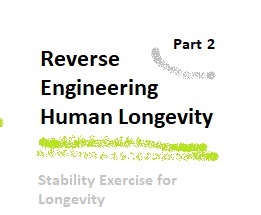| Last week I addressed the challenges of nutrition advise, and the chaotic nature of nutritional science. But if there was one piece of advise that was pretty universally accepted as being as close to a fact as possible when it comes to eating for longevity it was to EAT LESS OFTEN. Which isn’t the same as eat less, just less often. Now the fun part. Exercise for longevity. I love this topic as it is SO much more precise. Exercise is way closer to a one size fits all approach to living. There are few concepts, with many variations. A little incentive before I lay the groundwork. When it comes to longevity studies, they often refer to what is called “all cause mortality”. They want to see what stops you from dying from any non-accidental cause…ie. heart disease, cancer etc According to the JAMA published study, Physical Activity Recommendations and Decreased Risk of Mortality, following physical activity guidelines is associated with a 27% decreased risk of all cause mortality. That’s huge! Nothing else does that, and nothing so consistently. Exercise might be the most potent “drug” we have for extending the quality and perhaps quantity of our years of life. My Framework for Exercise If you have been following me for a while you know my framework for exercise is: 1) Lift Heavy Things (ie. resistance training twice per week) 2) Move Slowly Often (ie. walk every day) 3) Move Quickly Sometimes (ie. do high intensity cardio twice per week) But in order to do these things safely, you NEED to have STABILITY & MOBILITY. Keeping in mind that mobility without stability = injury. And that is why we start with stability over all else. Stability is the cornerstone upon which your strength and speed builds from. We often interchange the word stability with balance, but stability is more than that. It is the way we transmit force from the body to the outside world. For example, if you are lifting up 50 pounds, you want that lift to transmit from your muscles to the ground, without any of that leaking out in to your back or your knees or hips. Most injuries happen due to instability. And so, if you are a member of our studio you will probably remember that we almost always started you with stabilizing exercises like Bird Dogs. If you were good at those we would have moved you on to our favourite core stability exercise, the Dead Bug. We also probably threw in a mini band lateral walk or a clamshell exercise. |
| These are all safe exercises for beginners that help us assess and wake up your stabilizing muscles in the core and hips, but also easily progressed into more challenging exercises as you get stronger. If we did our job right, we also would have thrown in some exercise that works the stability muscles of the shoulder. The shoulder is one of the more dynamic joints in the human body, in that it requires an incredible balance of mobility and stability. That is the job of the rotator cuff, they coordinate movements to stabilize the shoulder joint. This wall slide pictured below is an excellent exercise for shoulder stability and mobility but requires a fair bit of flexibility to be done right and so a different exercise might have been right for you. |
In conclusion, even if you are already an avid exerciser, revisiting these basics is always beneficial. The bonus, for stability exercises, minimal equipment is required, and you just need to focus on high reps, low weights. Stabilizing your joints is the most consistent way to protect the joint from injury while creating the foundation required to optimize strength and performance. If you need help designing your own stability program be sure to book an appointment with one of our professional trainers today! |













